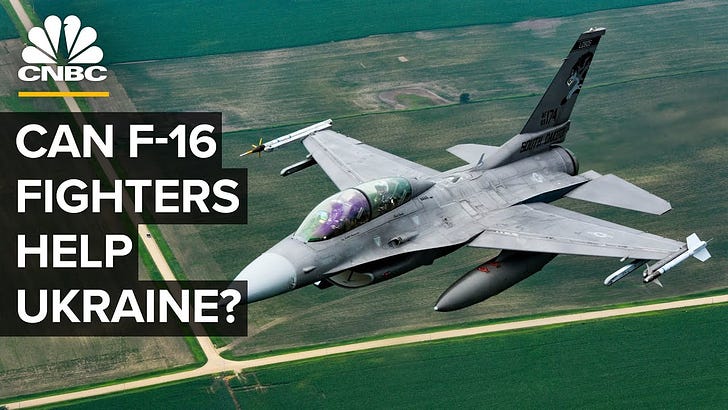Non-State Actress #11: Sending F-16s to Ukraine Is Like Being in Your Boyfriend’s Sister’s Wedding
Also, I was on TV.
Review: Non-State Actress #10: He’s Just Vlad broke down why there is a war in Ukraine and why it is important to continue our commitment to Ukraine. There is a war in Ukraine because a man who takes a lot of pictures of himself without a shirt while holding wildlife is the leader of Russia, and he’s been telling us for decades that he doesn’t think Ukraine is a real country or that Ukrainian people are human beings. It’s important for the US to defend Ukraine because genocide is a warcrime and when someone tells you they want to take over a continent *and then tries to do that,* you get involved.
BLUF
The United States continues to support Ukraine as it defends itself against a violent, illegal Russian invasion. The goals of US support are important to understand so that we can see why and how security assistance is about more than blowing things up. Basically, we’re starting to look a little deeper at the ‘M’ of DIME(FIL).
Press Play
Music is my preferred playlist, and not simply because I am vain lyric-coloratura soprano. However, since I *am* vain I am subbing our usual playlist with a video from CNBC. Why? Because I am in it :).
A Love Note to Lists
Readers of the recent ‘Senate Holds Are Like Unsolicited Dick Pics’ piece were surprisingly appreciative of the list State Department list I linked to. The list (since updated) provides a breakdown of what material goods and resources the US has provided Ukraine, and how the transfer happened (a sale, an exchange, through training, etc.)
Most of the questions and comments from that post were about that list and about ‘all the different and cool thing the US military apparently does’ that most people don’t know about. You’d think at least someone would have asked about the titular comparison, but readers really seemed to get that.
Color me shocked for knowing what I am doing. Perhaps it is because *checks notes* I am actually an expert in what I do and I work hard at it1.
I took the feedback to mean that not only was I spot on in sharing the chapter excerpt, I needed to buckle down on primers of the military services and their functions, and that while there are a ton of headlines on Ukraine, those headlines still fail to give the people what they want.
Two Artistic Representations of What is Not Happening:
Since then I’ve written about 35 pages on the US military services and their service cultures (mostly in comparison to various craft supplies), a 12ish page general explainer of what the military actually does, and a whole lot about Ukraine. I also recorded my first ever national TV interview for a major network and successfully pitched a dream outlet about contributing regularly as a freelancer.
I’m also keeping a hand on the wheel at my day job, planning a massive conference, and asking myself (and everyone around me) if I am ‘doing enough.’ Basically, I am absolutely the average millennial.
Giving the People What They Want
The most common questions about the war in Ukraine came down to:
What are we (the US and NATO) sending, why, and is it working?
Now, this is an exciting question for me, because it touches on a level of tactics we haven’t gotten into much yet. Also, it gives us a reason to briefly mention defense spending, the defense budget, and congressional oversight. It’s a good time all around.
At the same time, it can be catastrophically boring. So let’s not let that happen.
Ok. Let’s start with what are we sending and why:
As I mentioned in our previous post, one of the really great things about living in America is that the government publicly lists all the items, trainings, and materials America has provided to the Ukrainian government on the internet!
This is done by one of my favorite (yes I have favorite parts of government in the same way that normal people have favorite TV shows or flavors of ice cream) offices, the State Department’s Bureau of Political and Military Affairs! Called the PM Bureau for short, the Bureau of Political and Military affairs is responsible for all of America’s security partnerships. Training with and for other governments and militaries, negotiating and implementing international agreements, weapons and systems sales. They do a lot of cool and important things, and if I explain them all here you’ll have no reason to read my book.
As great as the PM Bureau and this wonderful list are, the list and the Bureau’s presentation and communication of it is far from helpful.
It isn’t helpful unless you know what a Patriot Missile System, how much it costs, and why it’s different than HIMARS - or High Mobility Artillery Rocket Systems2.
It isn’t helpful unless you know what a Mi-17 helicopter is, how much the US military does or doesn’t need them, and why it makes sense to send some to Ukraine3.
It isn’t helpful because it is a bulleted list of things that an increasingly small percentage of the US population has any point of reference to4 - and yet it is the main public record of security assistance sent to Ukraine.
I am not a weapons expert, but I know more than ~95% of the American population and have some friends who can fill in that % gap5. Going through the entire list of items and explaining what the system does, how it works, and why it specifically makes sense for Ukraine is my idea of a good time - but it isn’t a good use of yours.
And that brings us to the F-16.
What the F-16
In the last few weeks or so, you may have heard or seen a lot of headlines about F-16s being sent to Ukraine. If this sounds familiar, good job! If you have no idea what I’m talking about, ALSO good job - and please teach me how to turn off news alerts on my phone.
The F-16 or ‘Fighting Falcon,’ is a fixed-wing (meaning it’s a plane, the wings don’t move like a helicopter), single pilot fighter. Originally designed and manufactured by General Dynamics in 1974 but produced by Lockheed Martin since 1993 (General Dynamics sold their aircraft making stuff to Lockheed), there are at least 8 different variations that generally all come in single- and double seat options6. Really, there are nearly infinite variations but basically there are 8 models that can be and are altered and customized dozens upon dozens of times. Also, usually the second seat is for instructors during training. Or for snacks7.
The F-16 is the most commonly used fixed wing aircraft in the world. It’s used by the US Air Force for combat operations, demonstrations, and adversary/aggressor aircraft by the Navy - and it’s in use by more than 25 other militaries in the world. This part is important.
The F-16 is used by so many different countries for a few main reasons:
-It’s been around a long time, meaning it’s maintenance and technology is pretty well understood and there are a TON of them
-More variations means more variety and customization
-The fact that its common and popular makes it more common and more popular. Both because no one wants to be left out, and because of something called interoperability8.
Interoperability refers to the ability to actually work together, rather than simply plan to work together. It’s like the difference between going to Bahrain with or without an international cellphone plane or a power adapter.
A piece of equipment that is used by many different military services (Air Force, Navy) in many different countries supports interoperability because not only do many people know how to use it, many people know how to maintain it. Being interoperable means you can spend less time buying power adapters and more time smacking Vladimir Putin back to Russia :).
Control F(-16) the Point
These reasons, particularly the emphasis on interoperability, explain why it is both appropriate and important for the US to specifically send F-16s to Ukraine.
It is appropriate for the US to send F-16s to Ukraine because it is the Little Black Dress of airplanes:
We have way more in our closet than we’re actually wearing so if we don’t do something with it it just sits there taking up valuable real estate at the risk of being moth-eaten and forgotten.
It’s a proven classic that can be easily dressed up/down based on needs.
You have try really, really hard to use it wrong.
Why is important for the US to send F-16s to Ukraine?
This is the ultimate Hard Launch of a relationship.
Nothing says ‘We Are Together’ quite like sending F-16s. It’s like when your boyfriend’s or girlfriend’s sister asks you to be a bridesmaid in her wedding.
Is it the same as getting engaged or supporting Ukrainian NATO candidacy?
No.
Is it a sign of a long-term commitment of which there will be a lot of photographs visible in perpetuity that would be embarrassing to flake on?
Yes.
And show me a greater test of interoperability than being the bridal party of your boyfriend or girlfriend’s sister’s wedding.
I’ll wait.
It’s Not That Wild A Jump
You might think I sound crazy, but you don’t think I’m wrong. Because I’m not.
Let’s take a look at who has the F-16 and the current status of that nation’s relationship with the US.
We find, with one particularly important exception that we will address alongside reference to two of my own personal horror stories, a diverse collection nations that have strong strategic ties with the United States or are a strategic priority for the US910.
These are NATO Member States, EU Member States, nations with US military bases.
If the military is an element of national power (Remember that post!), and a big part of national power is relationships then F-16s are the Hard Launch of US committed relationships. Only necessary once and in the case of a potentially unexpected coupling.
Basically, when the US allows F-16 to be sold or given to another government, the US is saying, ”We trust our feelings for you. We believe in us. We are sticking this landing and will not allow you to be overrun by an authoritarian invader and/or believe your preference for democracy and democratic partners is genuine and unshakeable.
We want the world to see our faces together on Instagram.”
The Real Proof Is in the Failures
When we look at the list of current and former users of the F-16, we might be surprised by who we see and don’t see. We don’t see the United Kingdom, Canada, Australia, France - nations with long-standing partnerships who either can make their own equivalent airplane or don’t need one because they rely on the US for the capability.
We don’t see China or Russia, two autocratic nations. Makes sense.
But - we see Venezuela11. And if someone had told me Venezuela had F-16s years ago, I probably would not have brought a guy I went on 2 dates to my parent’s vow renewal in high school, or my college boyfriend to an immediate post-college immediate family member wedding. Because WOW are all those pictures a mess.
That sinking, awkward, uncomfortable feeling that comes up when someone asks “Whose that?” in reference to a 19-year-old who called himself ‘C-Money’ that you met maybe 3 times total in an image from your parent’s vow renewal 15ish years ago? That’s what it feels like when you realize a country ruled by a dictator, a country with no US embassy, has F-16. No one wants that feeling.
If the US is giving F-16s to Ukraine, what does that say about how the US sees its future relationship with Ukraine? And the future of Ukraine overall? And what does it mean?
Wrap It Up
It’s going to take a while to get F-16s to Ukraine, and even more time for those F-16s to leave the ground. And that’s kind of the point.
The point is the US is saying ‘Defending Ukraine is a short, medium, and long-term priority. We’re here as long as you’re here.’ It’s proof of commitment to training and maintaining, just like your smiling un-wed face in your boyfriend or girlfriend’s sister’s wedding pictures.
Giving Ukraine F-16s is more than giving a democratic nation the tools it needs to fight off invasion. Giving Ukraine F-16s is sending a message about how the US values Ukraine as clearly as Putin states he intends to reestablish the Soviet Union by murderous force.
It says ‘We use the F-16. Denmark, Poland, Norway, The Republic of Korea, Taiwan, Israel, The Netherlands, Romania all use the F-16. This is the long-time, highly interoperable tool of US allies and Ukraine is our ally.’
Gimme More
Bureau for Political and Military Affairs - US Department of State
US Air Force Information Sheet on F-16 Fighting Falcon
Lockheed Martin F-16 Fast Facts Sheet
List of Assistance to Ukraine as of August 22, 2023 - US Department of State
August 29, 2023 Announcement of More Aid to Ukraine - US Department of State
Breaking A DIME(FIL) Into Pennies - Non-State Actress
Everything the Light Touches is NATO - Non-State Actress
NATO and the Neighborhood Bar Creep - Non-State Actress
Basic Timeline on Venezuela - BBC
I’m still on that Barbie high. Sorry, not sorry.
There are a number of differences in how they work (shooting things down vs blowing things up) but what really matters is one can be moved easily and the other is pretty stationary.
The Mi-17 is the Soviet/Russian version UH-60 Blackhawk helicopter. The US doesn’t use them, but a lot of former Soviet countries have them on hand, the parts are pretty cheap, and they do the job. It makes sense to send them to Ukraine because Russian-legacy equipment is part of every-day military life, lots of other countries have them laying around, and no one will miss them.
Don’t worry, Non-State Actress is here to save the day.
About 7% of the current US population has served in the US military. Subtracting for those who have no weapons knowledge, adding back in my non-veteran and military colleagues who specialize in weapons, I’m calling it about 95%. Also shout out to Dr. John Gordon, my Military Operations and Weapons History Professor years ago who made me so many charts and flashcards.
I say at least because within each variation there are variations.
I’m kidding, relax.
I wrote a paper in grad school call ‘A Giant Pile of Spaghetti: Mission Names, Interoperability, and Bosnia.’ Turns out my professor at the time had helped name the mission I wrecked. My bad.
What’s a strong strategic tie? A US military base, shared membership in NATO, a long history of US- and Coalition-Led military training and institution building. A deeply engrained shared history.
And what’s a strategic priority? A place (often times the result of literal geography) that the US not only wants to be attached to, but wants to make sure adversarial powers and nations are NOT. Like, Taiwan - which lives under constant threat of invasion by the Chinese Communist Party simply because it desires a democratically elected government.
There is a lot to say here but this post was so long. I promise to come back to in on a podcast!
Venezuela was colonized by Spain in the early 1520s and declared its independence in 1810 (thanks, Napoleon ). The nation has struggled with violent coups, military dictatorships, and authoritarian regimes on and off since 1908. There’s an argument to be made that the guy I brought to that vow renewal is in a similar situation, but thats a conversation for another day.
In 1983, Veneuzuela was one of the first countries the US exported the F-16 to and was one of the only exceptions to the 1977 US self-imposed embargo of advanced weapon sales to Latin America. 10 years later, then-President Perez is impeached on corruption charges and by 1998 (only 15 years after the sale of the F-16s), Hugo Chavez is elected and replaces the Venezuelan constitution. He enforces an aggressively anti-US foreign policy and in 2001 forcibly redistributes land and wealth. After an attempted coup, Chavez eliminates the free press, increases prison terms for the “slander of public officials” (2005) and in 2006 cements a deep relationship with Russia through the purchase of Russian weapons. The relationship remains today under Nicholas Maduro, who assumed the presidency after Chavez’s death. Chavez has ruled Venezuela by decree since 2015 and he is not the recognized leader of Venzuela by the Organization of American States, the Lima Group, and other key organizations in the hemisphere. We’ll come back to this topic. A lot. And also to the former Acting, democratically elected President, opposition leader Juan Guaidó.














